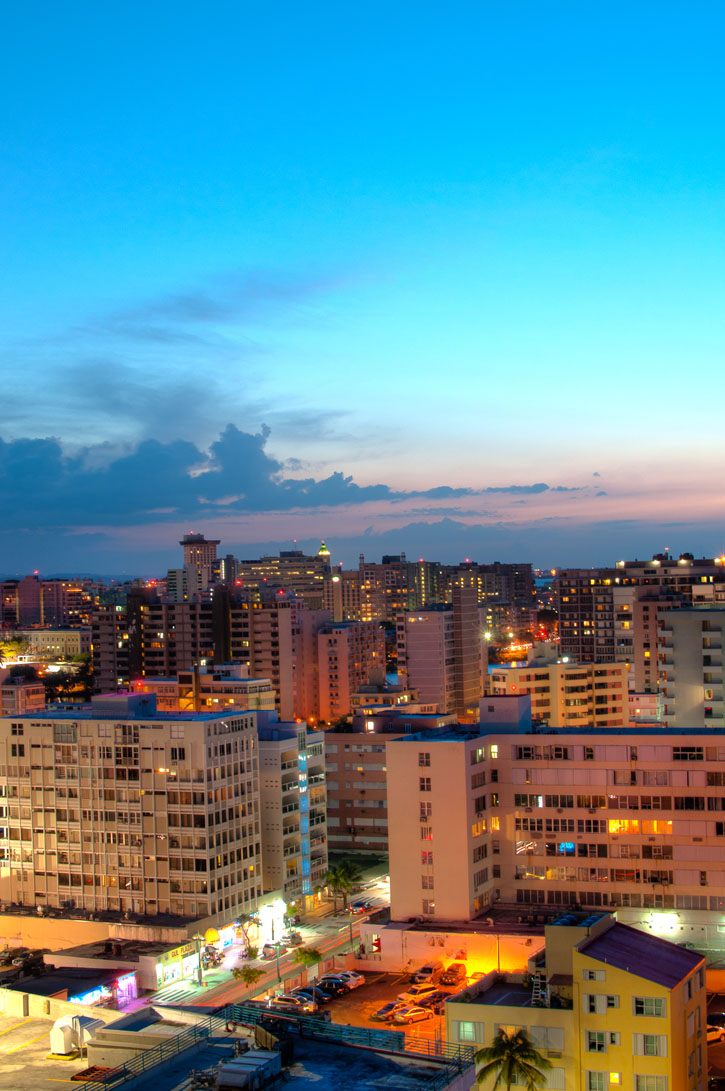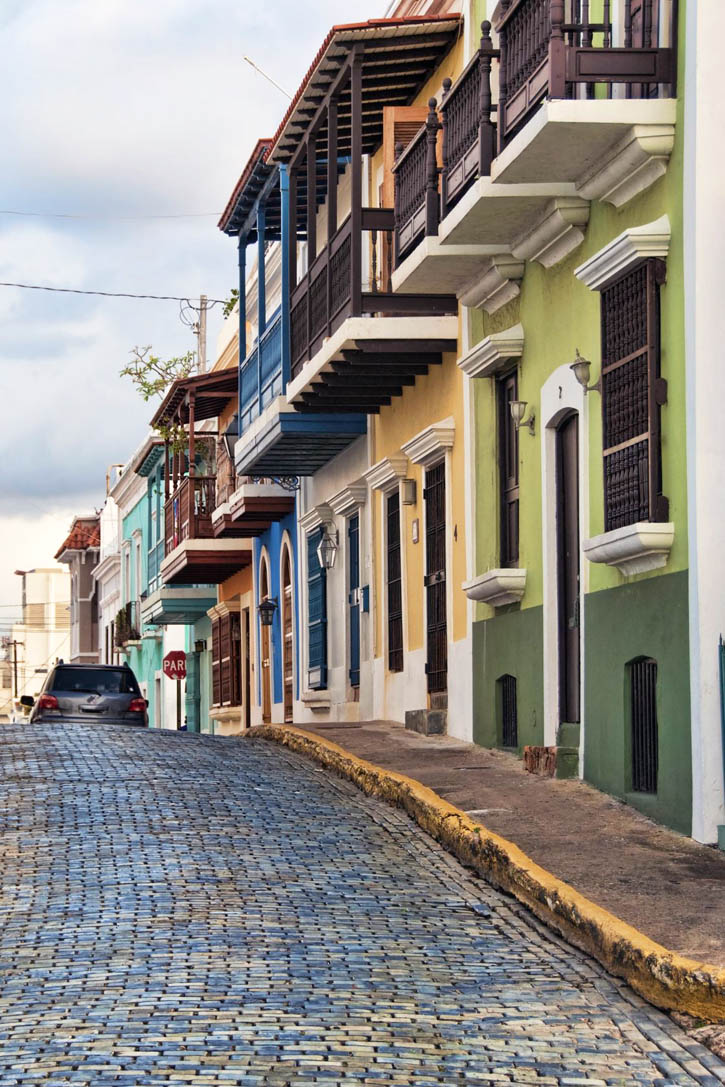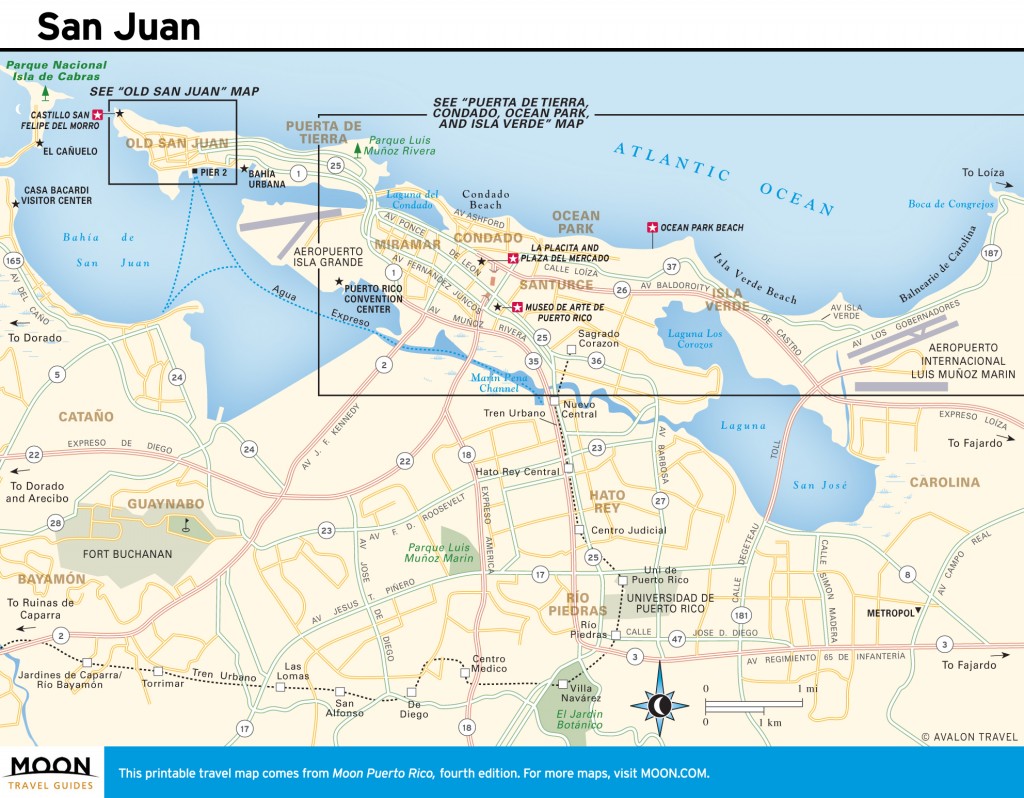San Juan, Puerto Rico, is arguably the most cosmopolitan city in the Caribbean.
San Juan’s natural beauty is apparent in its miles of sandy beaches, its shady plazas, and its beloved coqui, a tiny tree frog whose “co-QUI” song fills the night air.The second-oldest European settlement in the Americas, it is a place where world-class restaurants and luxury hotels compete for space alongside glitzy nightclubs and casinos; where Spanish colonial and neoclassical buildings line cobblestone streets; where designer stores and import shops beckon spend-happy tourists; where art, music, and dance thrive in its theaters, museums, and festivals; and where you’re never very far from wide strips of sand and surf, ideal for sailing, sunbathing, and swimming.
The San Juan, Puerto Rico, skyline at night. Photo © Dmitry K, licensed Creative Commons Attribution.
Situated on the northeastern coast of Puerto Rico, San Juan stretches along 25 miles of coastline and 10 miles inland. It spans 30,000 acres of coastal plain, encompassing rivers, bays, and lagoons, and is home to 1.1 million residents in the greater San Juan area. Established by Spain as the island’s capital in 1521, the city’s early role as a military stronghold is evident in its 16th- and 17th-century fortresses and a nearly 400-year-old city wall erected around the oldest part of the city to protect it from foreign attacks.
The heart of the city is historic Old San Juan, a 45-block grid of blue cobblestone streets lined with pastel 16th- to 18th-century buildings trimmed with ornamental ironwork and hanging balconies. By day its streets crawl with tourists shopping for souvenirs and designer duds. At night it throbs with locals and tourists alike, both partaking of some of the city’s finest restaurants and nightclubs.

In historic Old San Juan you’ll find blue cobblestone streets lined with pastel 16th- to 18th-century buildings. Photo © jovannig/123rf.
But Old San Juan is only the tip of the city. Travel eastward to Puerta de Tierra, a small, shady neighborhood with a lovely park, a small stadium, a classic hotel, and the closest public beach to Old San Juan. Continue eastward along the coast to Condado, considered the city’s tourist district. High-rise hotels, condos, and apartment buildings overlook the Atlantic Ocean. High-end shops line the main thoroughfare, Avenida Ashford, and many fine restaurants and casinos serve night crawlers.
Farther eastward is Ocean Park, a fine stretch of beach with a stately residential community and a handful of guesthouses and restaurants. Beside it is Isla Verde, where the city’s best beaches and most exclusive hotels are, along with fast-food restaurants and a cockfight arena.
Though it may seem so, San Juan isn’t all beachfront property. Condado is the seaside strip of a sprawling, working-class sector called Santurce, which has in recent years transformed into a vital contemporary arts district accompanied by a profusion of hip new restaurants, bars, and shops.
Across the Condado lagoon is the neighborhood of Miramar, a high-rise residential community and home of the Puerto Rico Convention Center, the largest of its kind in the Caribbean. Travel inland for a locals-only experience in Hato Rey, San Juan’s commercial district; Río Piedras, home of the Universidad de Puerto Rico; and Bayamón, a bedroom community.
As in any large city, all is not paradise. San Juan is a densely populated metropolis thick with automobile traffic. A heavy cruise-ship trade dumps thousands of tourists in the city several days a week, and the number of trinket shops catering to day-trippers has proliferated. Burger Kings and Pizza Huts are not an uncommon sight. Neither are pockets of poor neighborhoods, some of whose residents contribute to a petty street-crime problem.
But despite its big-city ways, San Juan’s natural beauty is apparent in its miles of sandy beaches, its shady plazas, and its beloved coqui, a tiny tree frog whose “co-QUI” song fills the night air. Puerto Rico is a commonwealth of the United States, and American influence is clearly present, but San Juan proudly maintains its Spanish heritage in its language, its culture, and its customs. And although the city is firmly planted in the 21st century, San Juan’s rich history endures in its carefully preserved architecture, its stately fortresses, and the hearts of its inhabitants.
It’s possible to hit San Juan’s highlights in one whirlwind long weekend, but it’s equally possible to spend a whole month here and not see all the city has to offer.
Six municipalities make up greater San Juan. They include San Juan, Cataño, Bayamón, Guaynabo, Trujillo Alto, and Carolina. The six sectors visitors gravitate to are Old San Juan, Puerta de Tierra, Condado, Santurce, and Ocean Park in San Juan and Isla Verde in Carolina. Not surprisingly, five of those areas are along the coast, and they are all within about 20 minutes of one another by car, taxi, or bus.
Several spectacular day trips are less than an hour’s drive east of San Juan, the most popular being El Yunque Caribbean National Forest, the rainforest, and Balneario La Monserrate (Luquillo Beach), considered one of Puerto Rico’s most beautiful beaches.

San Juan
Excerpted from the Fourth Edition of Moon Puerto Rico.